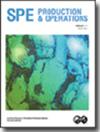综合力学地球模型预测出砂:一个案例研究
IF 1.3
4区 工程技术
Q2 ENGINEERING, PETROLEUM
引用次数: 2
摘要
出砂是油气井中一个严重的问题,也是生产工程师关注的主要问题之一。这个问题可能会损坏井下设备和地面生产设施。本研究介绍了一个出砂案例,并量化了伊拉克油田的出砂风险。该研究采用了构建一维力学地球模型(MEM)和预测出砂的综合工作流程,采用了多种标准,如钻井过程中的剪切破坏、B指数和临界井底压力(CBHP)或临界下降压力(CDDP)。电缆测井数据用于估计现场地层的力学性质。根据现场的出砂历史,对预测的出砂倾向进行了验证。本研究中预期的一些井的解释结果表明,当钻井过程中发生剪切破坏时,B指数约为2×104MPa或更小,CBHP等于地层孔隙压力。在这种情况下,应在生产的初始阶段进行防砂。另一方面,当不存在剪切破坏时,B指数总是大于2×104MPa,CBHP大多小于地层孔隙压力。在这种情况下,随着储层压力的降低,防砂方法的实施可能会推迟。然而,对于预期油田,建议在油井生产的初始阶段进行防砂,即使CBHP小于地层孔隙压力,因为当储层压力降至接近初始储层压力的值时,出砂将是不可避免的。对应力状态的初步评估表明,正断层可能是地层的应力状态。对于正断层应力状态,该研究解释说,当储层渗透率各向同性时,裸眼垂直井筒比水平井筒产生砂的倾向更小。此外,当井筒方位在最小水平应力的方向上时,CBHP将低于任何其他方位,并且在更高的井筒倾角下会发生出砂。对于预期油田,由于casedhole井的完井和储层渗透率的各向异性,在最小水平应力方向上钻探水平井,并在最大水平应力的方向上定向射孔是控制出砂的一种替代方法。本文章由计算机程序翻译,如有差异,请以英文原文为准。
Integrated Mechanical Earth Modeling for Predicting Sand Production: A Case Study
Sand production is a serious problem in oil and gas wells, and one of the main concerns of production engineers. This problem can damage downhole equipment and surface production facilities. This study presents a sand production case and quantifies sanding risks for an oil field in Iraq.
The study applies an integrated workflow of constructing 1D Mechanical Earth Modeling (MEM) and predicting the sand production with multiple criteria such as shear failure during drilling, B index, and critical bottomhole pressure (CBHP) or critical drawdown pressure (CDDP). Wireline log data were used to estimate the mechanical properties of the formations in the field. The predicted sand production propensity was validated based on the sand production history in the field.
The interpretation results of some wells anticipated in this study showed that when a shear failure occurs during drilling, the B index is around 2 × 104 MPa or less and the CBHP is equal to the formation pore pressure. For this case, sand control shall be carried out in the initial stage of production. On the other hand, when the shear failure does not exist, the B index is always greater than 2 × 104 MPa, and the CBHP is mostly less than the formation pore pressure. In this case, implementing sand control methods could be postponed as the reservoir pressure undergoes depletion. However, for the anticipated field, sand control is recommended to be carried out in the initial stage of well production even when the CBHP is less than the formation pore pressure since sanding will be inevitable when the reservoir pressure depletes to values close to the initial reservoir pressure.
The tentative evaluation of the stress regime showed that a normal fault could be the stress regime for the formations. For a normal fault stress regime, the study explained that when the reservoir permeability is isotropic, an openhole vertical wellbore has less propensity for sand production than a horizontal wellbore. Moreover, when the wellbore azimuth is in the direction of the minimum horizontal stress, the CBHP will be lower than in any other azimuth, and sanding will take place at higher wellbore inclination angles. For the anticipated field, because of the casedhole well completion and the anisotropic reservoir permeability, a horizontal well drilled in the direction of minimum horizontal stress with oriented perforation in the direction of maximum horizontal stress is an alternative method for controlling sand production.
求助全文
通过发布文献求助,成功后即可免费获取论文全文。
去求助
来源期刊

Spe Production & Operations
工程技术-工程:石油
CiteScore
3.70
自引率
8.30%
发文量
54
审稿时长
3 months
期刊介绍:
SPE Production & Operations includes papers on production operations, artificial lift, downhole equipment, formation damage control, multiphase flow, workovers, stimulation, facility design and operations, water treatment, project management, construction methods and equipment, and related PFC systems and emerging technologies.
 求助内容:
求助内容: 应助结果提醒方式:
应助结果提醒方式:


